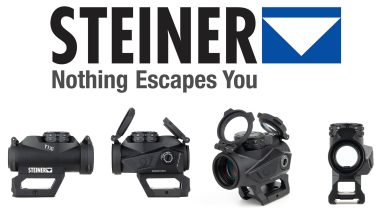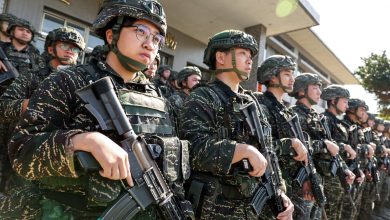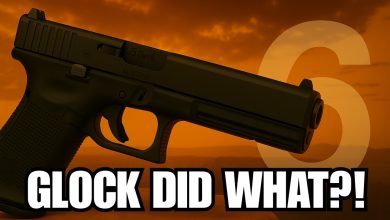Making The Perfect Shot

A seasoned shooter knows from personal experience that achieving on-demand, repeatable performance is paramount and that such consistency is the holy grail of shooting well. What are the underlying principles of developing the coveted skill of making the gun behave predictably, resulting in consistent, timely and effective round placement on demand?
The answer is to develop what performance shooters call “the perfect shot,” and recommend that it be the way you shoot every time you send a round downrange. What is this perfect shot? Before delving into the details, it’s important to first consider the context in which it is applied.
A common mistake among shooters is the mental approach to multiple rounds. Whether it’s repetitive rounds on the same target or multiple rounds applied to more than one target in transition such as a plate rack, the thought process should not be “I’m going to deliver five rounds.” Rather, the thought process should be “I’m going to deliver one precise, well-placed round, followed by another precise, well-placed round—five times.” Herein is the practical application of the perfect shot. The overarching idea is to think of delivering one perfect shot at a time regardless of the number of rounds, where they are placed, technicality of the target or accuracy and/or time requirements.
That hypothetical perfect shot is a byproduct of a shooting process codified by multi-world champion competitive shooter Rob Leatham, which is to “bring stability to alignment and break the shot without disrupting that alignment.” Meticulously and flawlessly following this process executed from start to finish is what produces the perfect shot. It’s certainly a simple enough concept to understand, indeed. However, developing the skill to do it repeatedly on demand is nowhere near as simple, as it raises salient questions such as when does this cycle of action begin? When does it end? What are the specific checkpoints along the way that must be met? The answers to these important questions are found in a series of subprocesses underpinning the overarching shooting process such as a mental process, a mechanical process and a visual process, to name a few.
Preceding any physical body mechanics is the mental process. Regardless of whether applying the shot combatively or in competition, the shooter must first identify a target. Is that a target? Is it the right target? Is it a shoot or no-shoot target? If it is a shoot target, then what are my options? What is my optimal shooting solution? The shooter must be able to lean on their depth of skill and experience to determine target difficulty (size, distance, movement, penalty, etc.) dictating the optimal shooting solution for that one shot.
Depending on the situation, whether in combat (is it necessary, legal and moral? If so, is there a good enough backstop?) or in competition (what is the designated string of fire? What are the required procedures?), there are questions. After answering all the requisite questions including the time and accuracy requirements, then the mind shifts from that of the problem solver to that of the silent observer. It now switches from deliberation mode to performance mode where the physical and mechanical subprocess begins.
(l.) Drawing your concealed handgun can be practiced at home with an unloaded pistol to ensure you maintain proficiency. (r.) Practice finding your natural point-of-aim so when you press the pistol out and open your eyes, the sights (or red-dot sight) are on target already. This exercise will shave precious seconds off your presentation when it counts.
The initial considerations of the mechanical process are firearm access, carry and deployment. Where is the handgun located? Inside the waistband? Outside the waistband? Appendix inside the waistband? Have you trained to the point where you can rapidly deploy your firearm? If so, how long does it take for you to work your way past any clothing, disengage any retention device(s) and acquire a positive master grip in the holster and then present the firearm from the holster with either strong hand only or both hands on the gun? If you have no idea how long it takes to present your firearm to the target at a particular distance and guarantee accurate round placement at that distance with alacrity, then it’s important you find that number so you know what you are realistically capable of as a baseline.
Here, you are presented with the first checkbox of the shooting-process checklist: “bring stability to alignment.” The presentation process should include a positive strong hand acquisition followed by a flawless draw intercepted and reinforced by your support hand on the way out to the target in as minimal a timeline and in the shortest distance (always a straight line) possible.
An often-underrated aspect of the presentation process, and integral to building stability, is to point the gun really well. You cannot move to the next steps unless you can first point the gun exactly where you want it. Easy as this may sound, like pointing your finger at a light switch, there’s a lot more to the story than meets the eye. Pointing the gun is a kinesthetic process leaning not on any type of visual process (other than target focus), but on your proprioceptors to successfully complete the task of bringing the muzzle to alignment with the intended target area.
You can only achieve this with multiple repetitions. It can be done dry, and it is recommended that you support your range practice with dry fire specifically by pointing the gun exactly where you want it as part of your presentation.
How many of us have needed to make small-scale corrections on the way out from the holster to the target to establish alignment? Each course correction is an unwanted input and costs valuable time. The greater the frequency and magnitude of such corrections, the more time it costs you. The more you practice pointing the gun, the fewer and less dramatic corrections will be needed for alignment, resulting in less dead time.
Pointing the gun well is integral to building stability, requiring a solid grip with the hands, sound structural integrity of the body and taming your arc-of-wobble—all executed in a compressed time frame.
A good grip means that you have a stable enough hand position and consistent (durable) grip pressure to maintain muzzle stabilization throughout the shooting process. Sound structural integrity means that you are using your elbows, shoulders and entire upper torso to fully support and maintain a stable firing platform. Completing the trifecta of a good hold is the ability to refine your arc-of-wobble as dictated by the specific shooting solution.
The trifecta of durable grip, structural integrity and refined arc-of-wobble is what facilitates hold control—one of the foundational skills emphasized in NRA marksmanship programs. Hold control is your ability to maintain a consistent and steady firing position while aiming to ensure muzzle alignment with your intended target.
The more technical the shot, the more you need to refine your hold control consisting of grip, structure and wobble. Refinement is the key to mastering hold control—the cornerstone of building and maintaining stability. It is the deliberate process of fine-tuning each aspect of the mechanical process to achieve optimal consistency and accuracy. Through refinement, inefficiencies are eliminated, and unnecessary input minimized.

(l.) A solid grip is a cornerstone of good shooting, helping keep the muzzle steady, the sights on target and the pistol as flat as possible. (r.) Your sights should be on the same plane as your line of sight, without having to move your head or the gun to gain alignment.
Grip is where refinement begins. Refining your grip means finding the optimal strong- and support-hand positions that distribute pressure evenly, minimizing shifts during recoil and developing myelination for consistency under stress. The refinement process transforms your grip into a durable and reliable shooting fundamental.
Equally critical is the refinement of structural integrity. Your shoulders, elbows and torso must work cohesively to provide a stable firing platform. This involves adjusting your stance and posture to maximize balance, foster efficiency and reduce unnecessary muscular strain, ensuring that your muzzle alignment remains consistent between shots. Refining this structural integrity means understanding how your body mechanics influence the firearm’s stability and making subtle adjustments to maintain a solid foundation.
As with the other two hold-control components, creating and sustaining an acceptable arc-of-wobble needs continual refinement. This refinement process requires consistent practice and greater demand—resulting in further development—of your fine-motor skills.
Grip, structural integrity and arc-of-wobble do not function in isolation. Refinement is what further integrates them into a cohesive, and ultimately subconscious, system that adapts to the technical demands of the shot. By honing these skills, you can elevate your hold control from a foundational competency to a fine-tuned skill with unwavering confidence. Refinement is not merely a step in the process—it is the process.
After completing the mechanical-process checklist for developing a good hold, then comes fire control, where you must maintain that hold while breaking the shot. Sustaining a good hold control during the break simply means maintaining alignment.
Traditional schools of thought consider the break as the very end of the shooting process and all else that occurs thereafter as “follow-through.” In other words, it is commonly believed that the boom signifies the end of the shot. Nothing could be further from the truth, as this is merely the midpoint in the mechanical process of a single shot.
In continuity of the single-shot process, the break then initiates a recoil sequence of muzzle rise, recovery and realignment. Each of these three also requires refinement. Observe your muzzle rise. Which direction did it go? Straight up? Left? Right? How high did it rise?
Next on the checklist is recovery. Did your sights recover to exactly where they started from? Was your point-of-impact exactly your point-of-aim? Did the muzzle scribe a 6-o’clock to 12-o’clock arc-of-movement? Are you now realigned with your original and intended point-of-aim?
Equally critical is the refinement of structural integrity. Your shoulders, elbows and torso must work cohesively to provide a stable firing platform.
You can’t fix something that you can’t see. Integral to the refinement process is that you first observe what is occurring and then make the mechanical process adjustments to refine your recoil-control process closer to the optimal and desired behavior. During this process, your trigger control should be commensurate with your realignment. Immediately following the break, you need to reset the trigger without delay. If you can hear the trigger reset after the break you are way too far behind the action/reaction power curve. The sound of the click on reset when drowned out by the gun’s report confirms a higher performance (efficient) trigger reset timing.
Experienced shooters understand optimal marksmanship lies in achieving repeatable, on-demand performance. The ability to place rounds consistently, effectively and with repeatable precision requires more than just skill; it requires a deliberate process.
At the heart of this lies the concept of the “perfect shot”—a single, flawless execution of mechanics and mindset that should define every round sent downrange. Rather than thinking in terms of firing multiple rounds, the shooter must approach each as an individual act of precision, delivering one perfect shot at a time. This mindset transforms repetition into mastery, emphasizing greater control, stability and refinement—regardless of the circumstances or target complexity.
The perfect shot is achieved by adhering to a structured shooting process that begins with stabilizing the firearm’s alignment and breaking the shot without disrupting it. While the concept may sound straightforward, its execution demands a deep understanding of interconnected mental, mechanical and visual subprocesses.
It starts with identifying and evaluating the target, determining the optimal shooting solution and transitioning from a problem-solving mindset to one of silent, focused execution. The shooter then engages in a mechanical process of firearm access, deployment and presentation, ensuring stability through appropriate grip, structural integrity and a refined arc-of-wobble. Each step contributes to a seamless transition from preparation to action, ensuring consistent alignment resulting in precise placement of rounds.
Mastery of the process does not end with firing the shot. The break initiates a sequence of recoil management, with each subcomponent requiring careful refinement. Through observation, practice and deliberate incremental adjustments, the shooter refines these components to achieve optimal performance. True shooting mastery is not merely about executing the perfect shot, but also about refining every aspect of the shooting process to make perfection repeatable on demand.
Read the full article here









